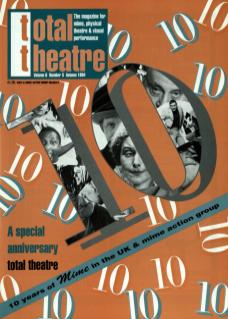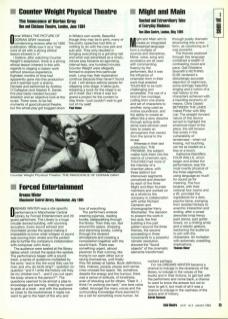Might & Main aim to create an integrated theatrical language from a multiple of sources and disciplines. Mime, voice, song and acrobatics are all used with commanding fluency by the performers. But it was the influence of cinematic form in their work that enabled Touched to be both challenging and accessible. The use of a kind of live montage, cutting from one scene and set of characters to another, song used as motive soundtrack, and the ability to create an effect like a slow dissolve through acting skills alone were devices used here to create an atmosphere that veered from the lyrical to the brutal.
Whereas in their last production, The Promise, the subject matter took them into the realms of cinematic epic, Touched had more of the intensity of a chamber piece, with three distinct but interwoven segments conceived and directed by each of the three Might & Main founder members and worked on as a whole by the company in collaboration with writer Richard Cameron and choreographer Kerry Ribchester. The decision to present the work in two acts, the first building a five-part pattern around the three themes, the second proceeding in three movements to a powerful climatic resolution, showed the ‘found objects’ of the cinematic elements transformed through purely dramatic structuring into a new form, as convincing as it was powerful.
The themes explored through this language contained a wealth of contrasting moods and paces. Gail Ghislaine Sixsmith's Nothing Else rendered a disturbingly accurate depiction of nightmare, some achingly beautiful singing and a notion of a real history to the characters achieved with a haunting economy of means. Chris Oades’ Between the Lines mated Pinter with Billy Liar. The straight forward nature of this device served to highlight the emotional heart of the piece, the still tension that exists in the vulnerability of tenderness – when not kissing, not touching, can be as loaded as a kiss or a touch.
Katherine Ratcliffe's Four Walls, which began and ended the performance, was the most overtly physical of the three segments, using language as much for sound as for meaning. The four tenants, with their notional four rooms and a lift, provided the ingredients for a dark, psycho-farce, swinging from isolated fantasy to anarchic interaction and ending, after a sweat drenched ninja frenzy (part dance, part gutter brawl), on a chilling smile and a robotic gesture, beckoning the audience to join with the characters. An invitation with extremely unsettling implications.

